AI Scheduling for Vertical Gardens
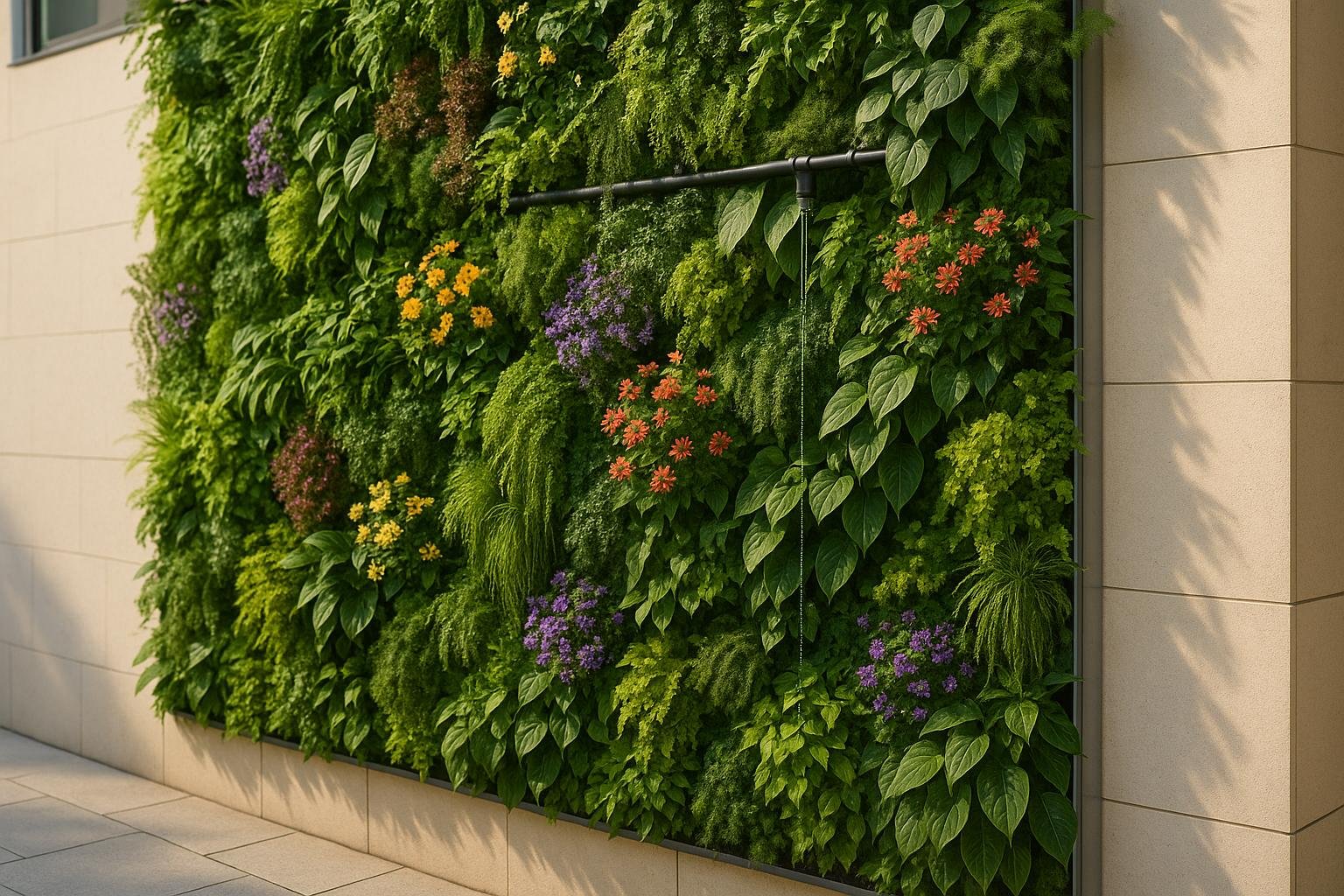
AI scheduling is transforming how vertical gardens are managed by solving one of their biggest challenges: efficient irrigation. Vertical gardening saves space but makes watering tricky due to uneven water distribution and varying plant needs. Here's how AI makes it easier:
- Precise Watering: AI uses sensors and weather data to deliver the right amount of water to each plant, reducing waste by up to 50%.
- Healthier Plants: Early detection of issues like diseases, pests, or nutrient deficiencies ensures plants thrive.
- Cost and Energy Savings: Automated systems lower water and energy bills while cutting labor costs.
- Improved Yields: AI-driven irrigation boosts crop yields by 20–30%.
AI systems like AIGardenPlanner simplify the process by offering tailored layouts, plant care advice, and automated irrigation schedules. Whether for a small balcony or a large setup, AI ensures efficient water use and healthy plants.
How AI is Transforming Vertical Farming: The Future of Food (Explained)

Key Components of AI-Optimized Irrigation Systems
Creating an AI-powered irrigation system for vertical gardens involves three key elements working in harmony. These components transform raw data into precise watering schedules tailored to the garden’s unique needs.
Sensors for Real-Time Data Collection
Addressing the challenge of uneven water distribution starts with reliable sensors. Soil moisture sensors are essential, as they measure water content at various depths across the vertical garden. Placing these sensors at multiple levels ensures that the system accounts for water variations throughout the structure.
Temperature and humidity sensors provide critical data on evapotranspiration rates, helping AI algorithms adjust watering schedules based on how quickly plants lose moisture. This ensures plants are hydrated exactly when they need it.
Advanced sensors go even further, monitoring plant-specific parameters like leaf wetness, canopy temperature, and stress indicators. These tools can detect early signs of water stress before visible symptoms appear, allowing proactive adjustments.
pH sensors are another vital component. They help maintain the ideal acidity levels in irrigation water, ensuring plants can absorb nutrients effectively. This is particularly important in vertical gardens, where nutrient solutions are often integrated into the watering system [5].
A real-world example of sensor effectiveness comes from the Smart Orchard Spray Application project, which achieved water savings of 14–26% using IoT-based precision irrigation [6].
AI Algorithms for Adaptive Scheduling
The system’s intelligence lies in its algorithms, which process sensor data and external inputs to create flexible irrigation plans. These AI tools analyze soil moisture, weather conditions, and historical trends to determine the specific water needs of each section of the garden.
Machine learning capabilities allow the system to improve over time, learning from past cycles and plant responses. Meanwhile, predictive analytics use weather forecasts, seasonal trends, and plant growth stages to anticipate future water requirements. This approach is particularly effective for the unique demands of vertical gardens.
"AI algorithms use historical data to predict weather patterns and irrigation requirements accurately." – DripWorks [4]
The system also handles unpredictable conditions with ease, thanks to fuzzy logic-based control frameworks [6]. These frameworks enable the AI to make smart decisions when sensor readings are inconsistent or weather conditions are erratic, minimizing risks and ensuring optimal watering.
"AI technology can analyze multiple factors, including temperature, soil composure, sunlight exposure, and humidity, to determine the exact amount of water each plant requires." – DripWorks [4]
Automation and User Interfaces
The final piece of the puzzle is automation, which brings the AI’s irrigation plans to life. Automated control systems manage programmable valves, pumps, and distribution networks, ensuring each zone of the vertical garden receives the right amount of water.
To make these advanced systems accessible, user-friendly interfaces are crucial. Mobile apps and web dashboards provide real-time updates on garden conditions, water usage, and system recommendations in an easy-to-understand format. These platforms often include manual override options, giving users the flexibility to make adjustments when needed. Alerts notify gardeners of system malfunctions, extreme weather, or plant health issues requiring immediate attention.
Integration is another key feature. AI irrigation systems can seamlessly connect with existing garden setups and smart home systems, coordinating irrigation with lighting and climate control in indoor vertical gardens. Additionally, energy optimization features ensure that watering occurs during off-peak electricity hours, reducing costs.
| AI Application | Efficiency Improvement |
|---|---|
| Leak Detection | 20–60% water savings |
| Precision Controllers | Over 40% reduced consumption |
| Low-Pressure Drip Systems | Over 50% energy savings |
Step-by-Step Guide to Implementing AI Scheduling for Vertical Gardens
Setting up an AI-powered irrigation system for your vertical garden involves careful preparation and a structured approach. This setup transforms your garden into an intelligent, self-regulating environment that adapts to real-time conditions and plant needs.
Step 1: Assess Your Garden's Requirements
Before diving into technology, take a close look at your garden's specific characteristics. Evaluate the total area, the vertical structure, and how plants are arranged. This helps in designing precise irrigation zones, as water pressure and distribution often vary across different levels.
Group plants with similar needs for water and light to create efficient irrigation schedules. You can layer plants strategically - placing sun-loving ones in areas with maximum exposure and shade-tolerant varieties in less lit spots.
Climate and orientation also play a big role. Gardens in direct sunlight need more water. Understanding local evapotranspiration rates helps estimate baseline water needs. For instance, in Phoenix, Arizona, summer evapotranspiration can hit about 6 liters per square meter daily (about 1.6 gallons), while in winter, it may drop to around 1.5 liters (roughly 0.4 gallons) [7].
Also, think about your water source and its quality. If you're using a recirculating system, poor water quality can lead to salt buildup and other problems. Testing the water’s pH and mineral content ensures it’s suitable for your plants.
Once you’ve outlined your garden’s needs, you’re ready to install the required sensors.
Step 2: Install and Configure Sensors
Carefully place sensors in critical areas of your garden to gather accurate data. These sensors track soil moisture, temperature, humidity, leaf wetness, and water pressure to provide a complete monitoring system [10].
- Soil moisture sensors are the cornerstone of your setup. Install them at various levels, near plant roots, to get precise moisture readings. Models like the SMT100 sensor and pressure sensors, paired with wireless gateways, are popular choices [10].
- Environmental sensors for temperature and humidity help the system adjust watering schedules by understanding evaporation rates. Many of these sensors offer high accuracy, detecting changes within ±1% [12].
- Pressure sensors monitor your irrigation network for issues like clogs, leaks, or pump failures, ensuring smooth operation [10].
- Leaf wetness sensors track moisture on plant surfaces, helping prevent fungal diseases by avoiding overwatering [10].
To tie it all together, use a wireless gateway system that collects and transmits data from your sensors. The Reporter wireless gateway system, for example, supports remote monitoring and ensures reliable signal coverage [11]. Follow the manufacturer’s calibration instructions for each sensor, and test the system for a week to identify any connectivity or functionality issues.
With the sensors in place and calibrated, you can now activate the AI system to manage irrigation.
Step 3: Set Up and Monitor the AI System
Using the sensor network as a foundation, configure the AI system to manage irrigation dynamically. Start by entering specific details about your garden - such as plant types, growth stages, and environmental conditions. This creates a tailored baseline for the AI to work from.
Link your system to weather services to include external data like forecasts, seasonal changes, and local climate trends. This boosts the AI’s ability to predict and adjust watering schedules based on upcoming weather.
Set the system to water at optimal times - early morning or late evening - to reduce evaporation. When properly configured, IoT sensors in urban farming setups can cut water usage by up to 50% [12].
Monitor the system closely for the first month to fine-tune its performance. Check that water is reaching all plant zones evenly, and adjust emitters if you notice dry spots or inconsistencies. Regularly inspect and maintain sensors and drip lines by cleaning surfaces, fixing clogs, and replacing any faulty components.
As your plants grow and seasons change, tweak the AI settings for watering frequency, duration, and timing. Many systems allow manual adjustments, which can be refined over time to match evolving conditions. Enable alert systems to notify you of critical issues, such as sensor failures or extreme weather. Mobile apps that come with these systems often provide real-time notifications and remote control options, so you can address problems even when you’re not on-site.
A 2020 study by Ochoa, Bañón, Bañón, and Molina-Martínez highlighted the benefits of frequent, low-flow irrigation combined with automated monitoring in vertical gardens. Their findings showed that well-configured AI systems can dramatically improve water efficiency and plant health [8][9].
sbb-itb-4d6a8dd
🚀 Ready to Reinvent Your Garden?
Join thousands of homeowners who have transformed their gardens using our AI design tool. Upload one photo to explore endless possibilities.
Get your AI garden designs →Benefits of AI Scheduling for Vertical Gardens
AI-powered irrigation systems are reshaping how vertical gardens are managed by delivering precise watering schedules that cut down on water waste and promote healthier plant growth. These systems outperform traditional manual watering methods in several key areas, from resource efficiency to plant care.
Water and Resource Conservation
AI scheduling brings a new level of precision to irrigation, reducing water waste by delivering the exact amount of water plants need, exactly when they need it. Unlike manual methods that often rely on fixed schedules or guesswork, AI systems use real-time data - like soil moisture levels and weather forecasts - to fine-tune irrigation timing.
For example, research shows that AI systems can cut water usage by 25–50% [4][6]. One study using an Arduino-based system achieved an impressive 99.5% reduction in water use, with an average decrease of 87.97% compared to manual watering methods [3].
These systems also adapt to changing weather conditions, skipping or adjusting watering sessions to prevent overwatering during rainy periods or underwatering during dry spells. By managing water more effectively, AI not only conserves resources but also creates the perfect environment for plants to thrive.
Better Plant Health and Growth
AI scheduling does more than save water - it ensures plants grow under ideal conditions. By maintaining consistent soil moisture levels and eliminating the stress caused by irregular watering, these systems meet the specific needs of individual plants [2].
AI systems analyze a range of environmental factors - soil moisture, temperature, humidity, and light levels - to determine exactly how much water is required. This approach prevents common problems like root rot from overwatering or stunted growth from drought.
The benefits go beyond watering. AI health monitoring achieves 99.4% accuracy in detecting diseases [1], enabling early intervention for issues like nutrient deficiencies or pest infestations. These systems also automate feeding schedules and adjust nutrient concentrations based on continuous growth tracking. Additionally, AI optimizes climate control by regulating temperature, humidity, and CO₂ levels, which can cut energy use by 30% while increasing yields. Studies show that this constant environmental adjustment reduces disease outbreaks by 30% and boosts overall yields [1].
Cost and Energy Efficiency
AI scheduling doesn’t just save water - it also cuts costs and energy usage. By automating irrigation, these systems reduce labor needs, lower water bills, and minimize energy consumption.
For instance, AI can detect leaks, apply water precisely, and adjust schedules based on real-time water demand and weather conditions [4]. This level of precision translates into significant savings over time.
| AI Application | Efficiency Improvement |
|---|---|
| Leak Detection | 20–60% water savings [13] |
| Precision Controllers | Over 40% reduced consumption [13] |
| Low-Pressure Drip Systems | Over 50% energy savings [13] |
Beyond cost savings, AI technology boosts crop productivity. Precision farming methods supported by AI can increase yields by 20–30% [4], while AI-enhanced irrigation systems show similar productivity gains [6].
Real-world examples highlight these advantages. In Uttar Pradesh, India, AI-driven irrigation systems helped farmers grow peas more efficiently, saving costs and water while increasing crop output. The fieldWISE platform identified over 100,000 hectares with critical soil moisture stress, benefiting 4,540 farmers with optimized water management practices [6]. Similarly, the Smart Orchard Spray Application project demonstrated 14–26% water savings through IoT-based precision irrigation [6], showcasing the economic and environmental value of AI scheduling.
Using AIGardenPlanner for Vertical Garden Irrigation
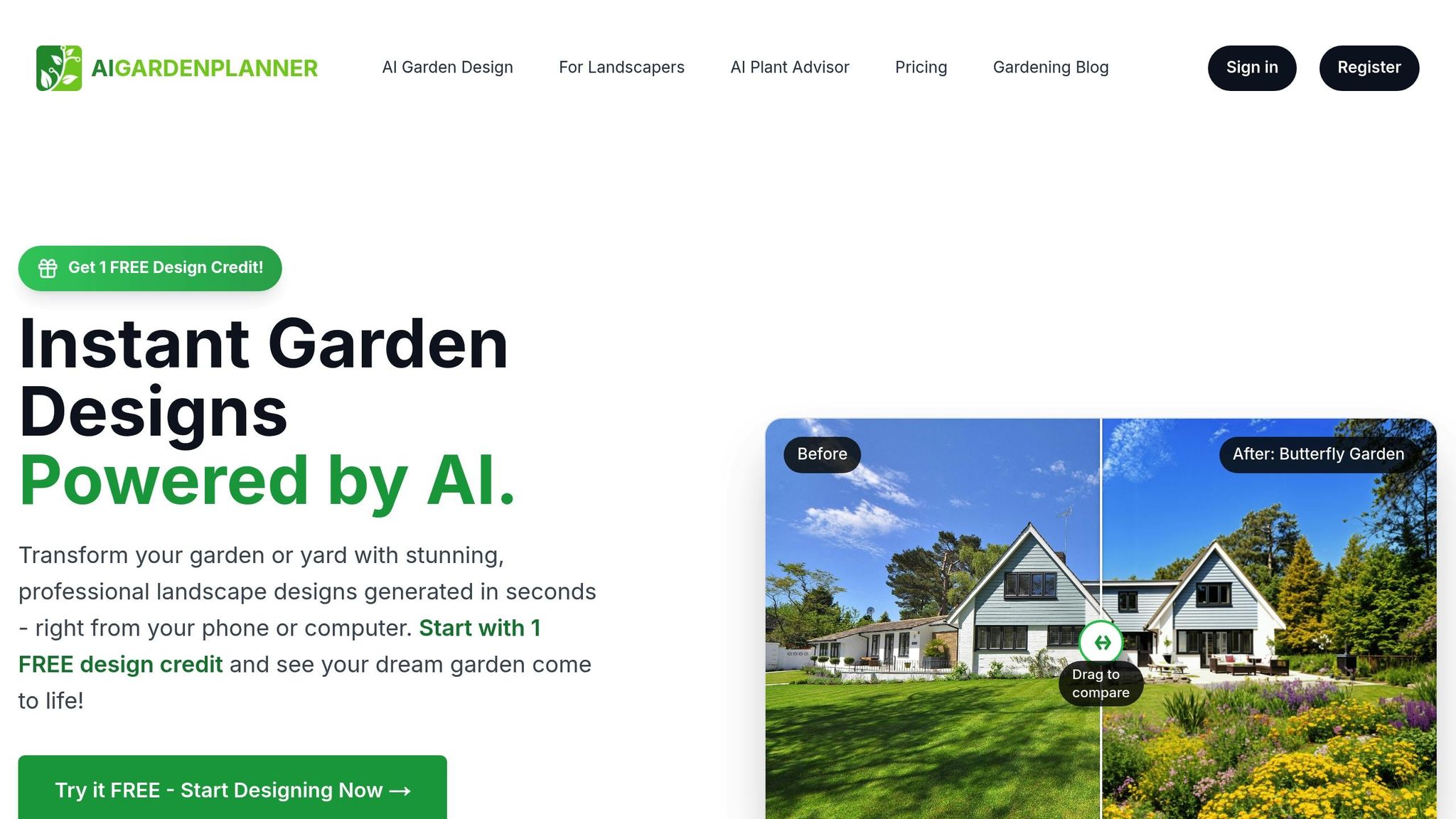
AIGardenPlanner takes the guesswork out of vertical gardening by combining advanced AI scheduling with tailored plant care and irrigation strategies. This tool simplifies the process, ensuring water efficiency and healthy plants through personalized recommendations.
Designing Vertical Gardens with AIGardenPlanner
AIGardenPlanner’s design generator uses AI to craft garden layouts tailored to your specific needs. By analyzing factors like space dimensions, climate, soil type, and location, it creates layouts that address the unique challenges of vertical gardening. All you need to do is upload photos of your space, input measurements, and let the AI handle the rest. The result? A design that optimizes plant compatibility, spacing, and water distribution.
"Having an AI design my garden layout, suggest suitable plants, and provide customized care instructions is absolutely game-changing!" - Ethan Bloomfield, Horticulturist [14]
The system works fast, delivering most plans within 5–10 minutes. For more complex designs, it may take up to an hour. Each plan is provided in an interactive PDF format and a mobile-friendly version, making it easy to use during setup and planting. This thoughtful approach sets the foundation for precise irrigation and plant care recommendations.
AI Plant and Irrigation Recommendations
AIGardenPlanner’s Plant Advisor takes things further by analyzing climate data, seasonal trends, and plant compatibility. It groups plants with similar water needs, ensuring efficient watering zones. Along with this, it provides detailed care instructions, including watering schedules, growth habits, spacing, and maintenance tips. Need advice on fertilizers, pruning, or pest control? The platform has you covered, offering strategies tailored to vertical gardening.
In testing, AIGardenPlanner recommended five plants for each garden bed, complete with information on their suitability, planting techniques, growth patterns, and irrigation needs [15]. This level of detail helps users create thriving vertical gardens with minimal effort.
Getting the Most from AIGardenPlanner's Features
Beyond layouts and recommendations, AIGardenPlanner enhances garden efficiency through smart plant groupings and irrigation strategies. With its custom style creation tool, users can design visually stunning vertical gardens that also prioritize water efficiency. Choose from over 50 pre-designed styles or create your own to match specific irrigation zones and plant groupings.
Seasonal guides are another standout feature, helping users adjust irrigation schedules throughout the year. From managing winter frost to summer heat and seasonal plant rotations, these guides ensure your garden stays healthy year-round.
For professionals, AIGardenPlanner offers commercial licensing options. These include priority support, early access to new features, and high-resolution design downloads that integrate seamlessly with irrigation planning software. Detailed growing guides also align tasks like feeding, pruning, and pest control with irrigation schedules, making it easier to maintain a high-performing vertical garden.
Conclusion: AI for Smarter Vertical Gardens
AI scheduling is transforming vertical gardening through real-time data, advanced algorithms, and automation. By using these tools, gardeners can achieve impressive results: up to 95% water savings, a 30% boost in productivity, and a 20–25% reduction in water and energy use[16]. These advancements make AI scheduling a game-changer for efficient and sustainable vertical gardening, especially as urban farming grows toward an estimated $236.4 billion market by 2028[16].
Integrated platforms, powered by advanced sensors and adaptive technologies, are taking vertical gardening to the next level. For instance, AIGardenPlanner offers a user-friendly solution that simplifies complex AI systems for everyday gardening. With a 90% success rate in detecting pests and diseases, personalized irrigation plans, and detailed growing guides, it’s a tool that caters to both beginners and experienced gardeners. Whether you’re tending to a small balcony garden or a larger vertical setup, this AI-driven platform ensures your plants get exactly what they need, when they need it.
AI scheduling ties together every aspect of garden care into a seamless, data-driven system. It’s not just about improving your garden today - it’s about creating a sustainable and efficient system for the future. Healthier plants, reduced costs, and year-round efficiency are just some of the benefits you’ll enjoy by adopting AI scheduling. With these tools, your garden becomes smarter, more sustainable, and perfectly in tune with the needs of your plants.
FAQs
How does AI figure out the water needs of plants in a vertical garden?
AI leverages cutting-edge algorithms to evaluate the specific water needs of each plant in a vertical garden. By analyzing real-time data - including soil moisture, light levels, temperature, and humidity - it ensures plants receive just the right amount of water for healthy growth, all while minimizing waste.
It doesn’t stop there. AI adjusts to dynamic conditions like seasonal changes or sudden weather shifts, fine-tuning irrigation schedules with precision. This approach not only supports plant health but also saves resources, making it an excellent solution for eco-friendly gardening.
What are the main advantages of using AI-powered irrigation systems for vertical gardens compared to traditional watering methods?
AI-powered irrigation systems bring a range of advantages to vertical gardens. For starters, they can cut water usage by 30–50%, making it easier to manage resources efficiently while encouraging healthier plant growth. These systems are designed to deliver consistent, precise watering tailored to the specific needs of each plant - something that's hard to replicate with manual watering.
Beyond water savings, these systems also streamline the entire irrigation process. By automating tasks, they save you significant time and effort, freeing you up to focus on other aspects of maintaining your garden. This makes them especially appealing for busy individuals or anyone managing larger vertical garden setups.
How does AIGardenPlanner help improve water efficiency and plant health in vertical gardens?
AIGardenPlanner takes advantage of cutting-edge AI to give you tailored plant suggestions that match your local climate. This ensures your vertical garden not only survives but thrives in its unique environment. Plus, it helps craft smart layouts designed to promote healthy plant growth while using water efficiently.
The tool also offers detailed care guides that walk you through every step - covering watering schedules, pruning techniques, and pest management. With AIGardenPlanner, keeping your vertical garden lush and thriving becomes simple, all while conserving water.
🎨 Visualize Your Dream Garden Today!
Transform any outdoor space into a professional landscape design in minutes. Just upload a photo, choose your style, and let our AI do the rest.
Start your garden transformation now →Related posts
Related Articles
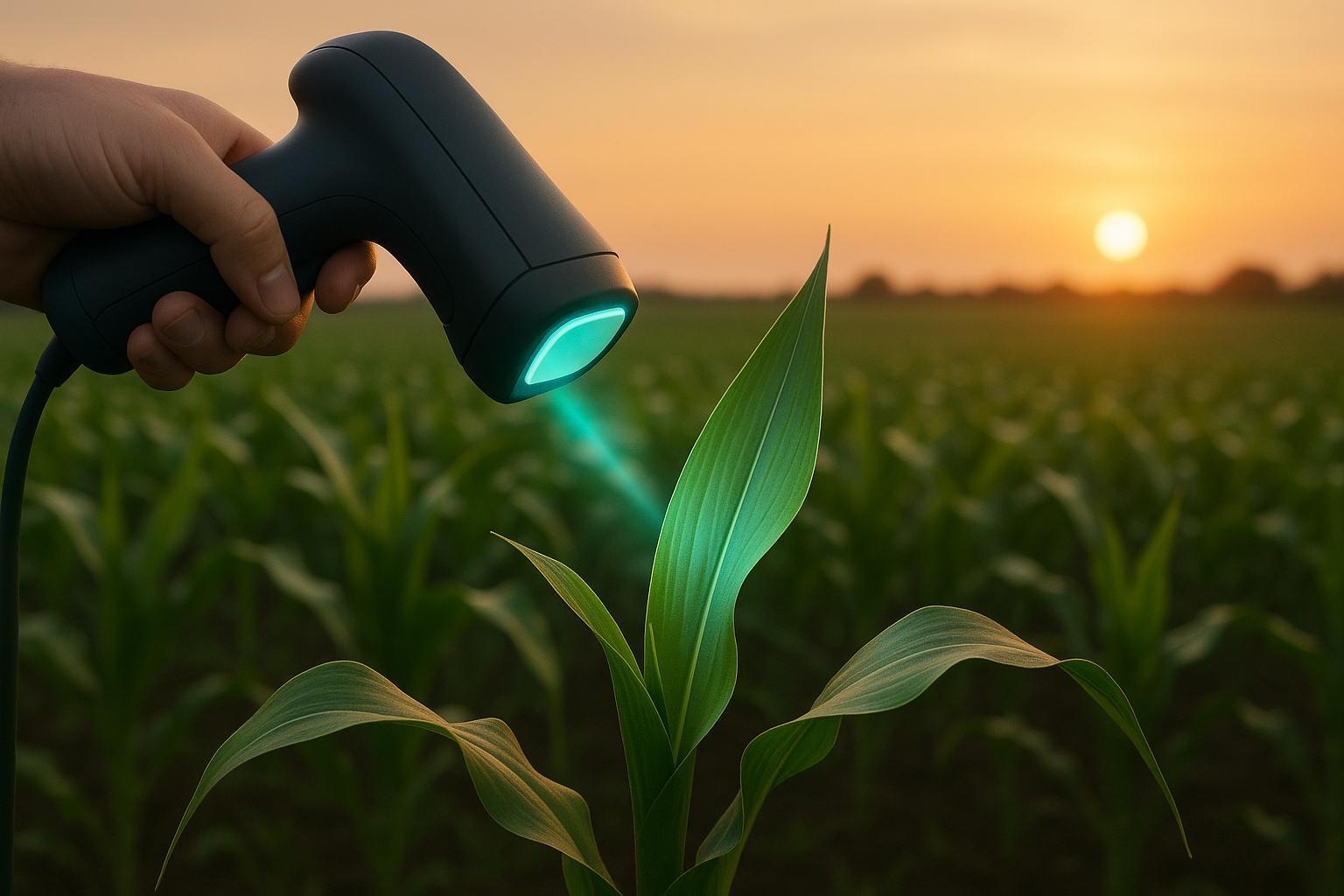
Imaging Techniques for Non-Destructive Disease Detection
Explore advanced imaging techniques revolutionizing non-destructive plant disease detection, enhancing early diagnosis and crop management.
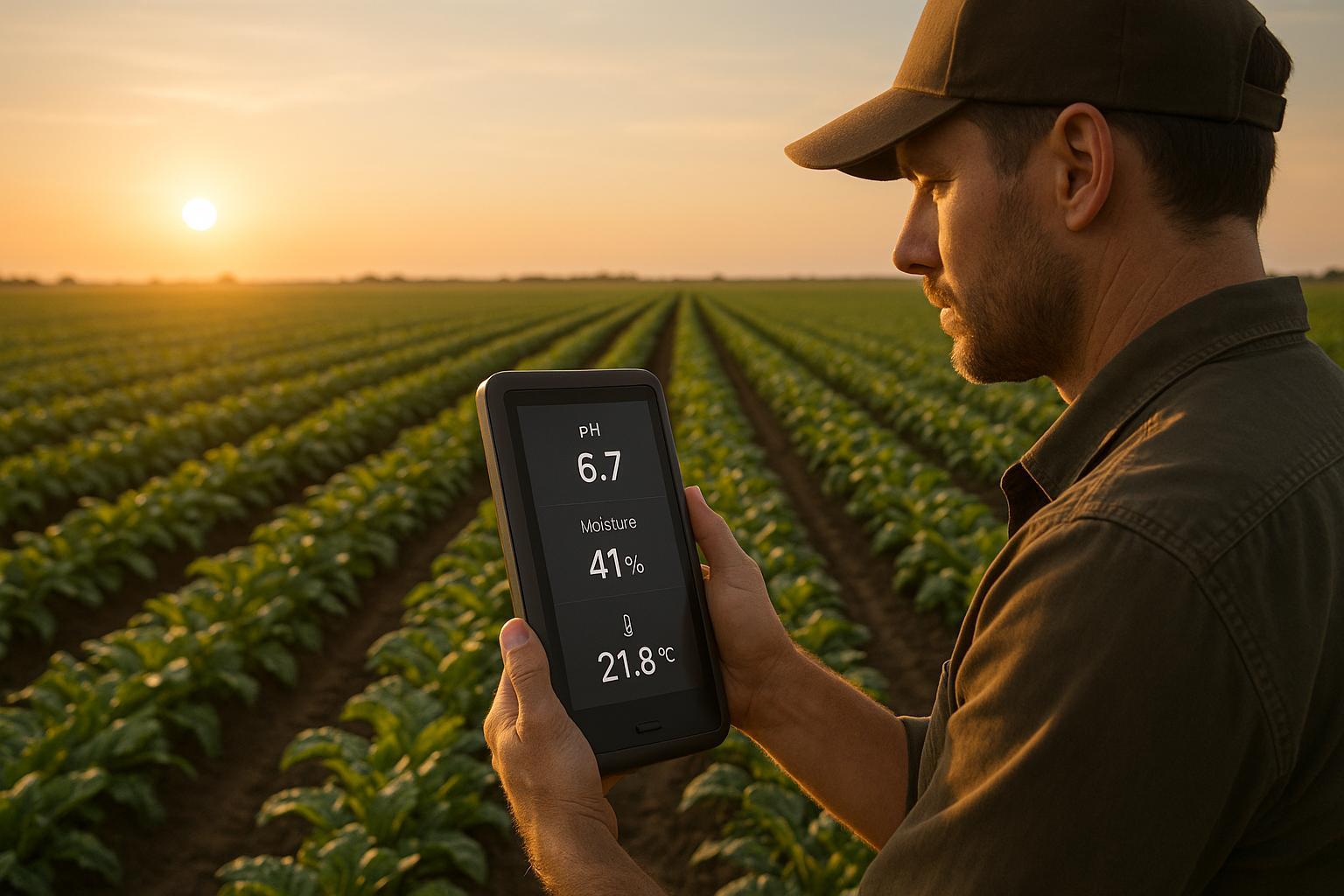
How Calibration Impacts Monitoring Accuracy
Effective calibration of monitoring tools is essential for accurate data, reducing pesticide use, and ensuring healthy crop management.

How Vegetation Density Affects Garden Microclimates
Explore how vegetation density shapes garden microclimates, affecting temperature, humidity, and plant health for a thriving outdoor space.
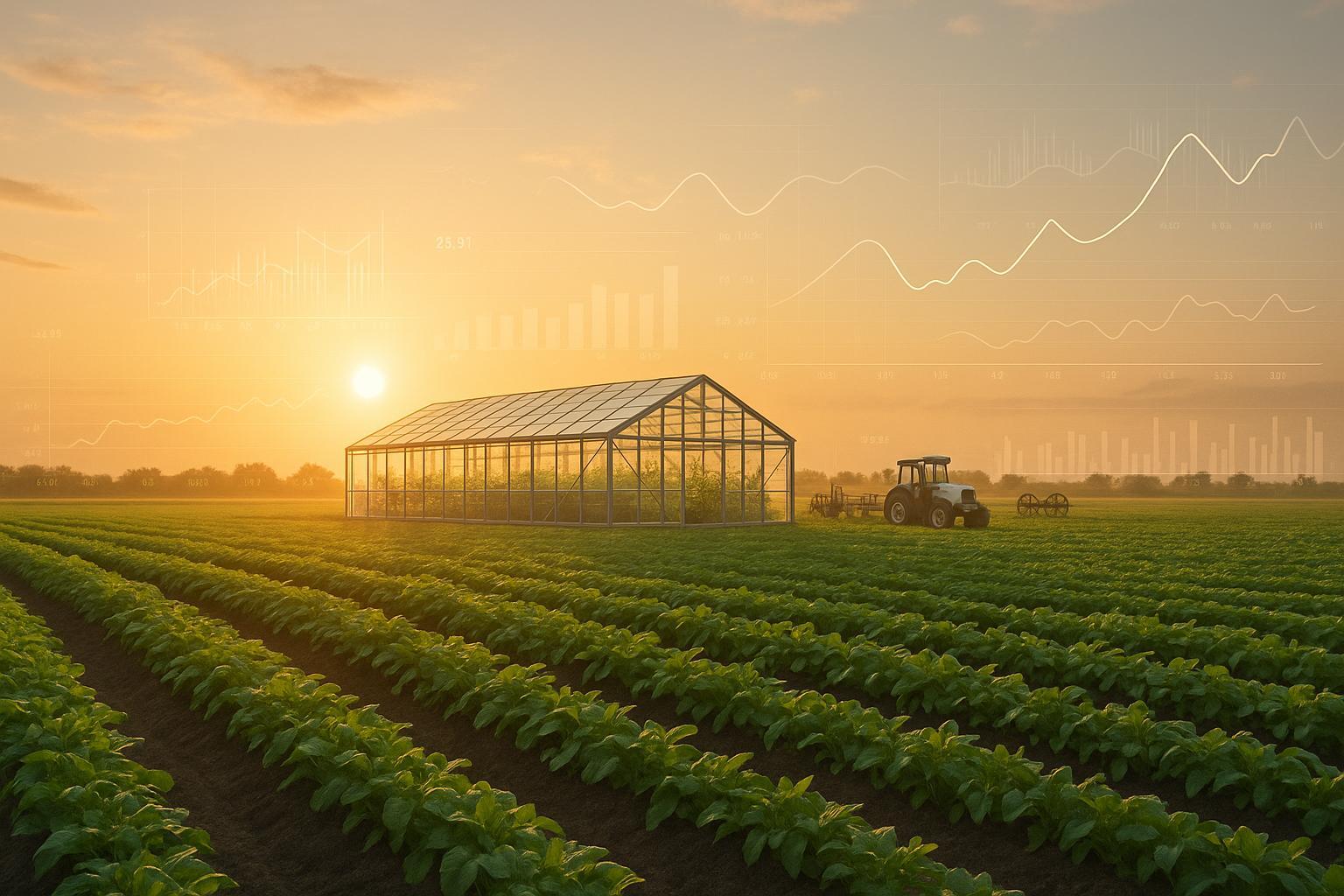
How Machine Learning Models Forecast Plant Growth
Explore how machine learning revolutionizes plant growth predictions, optimizing resources and improving yields for farmers and gardeners alike.
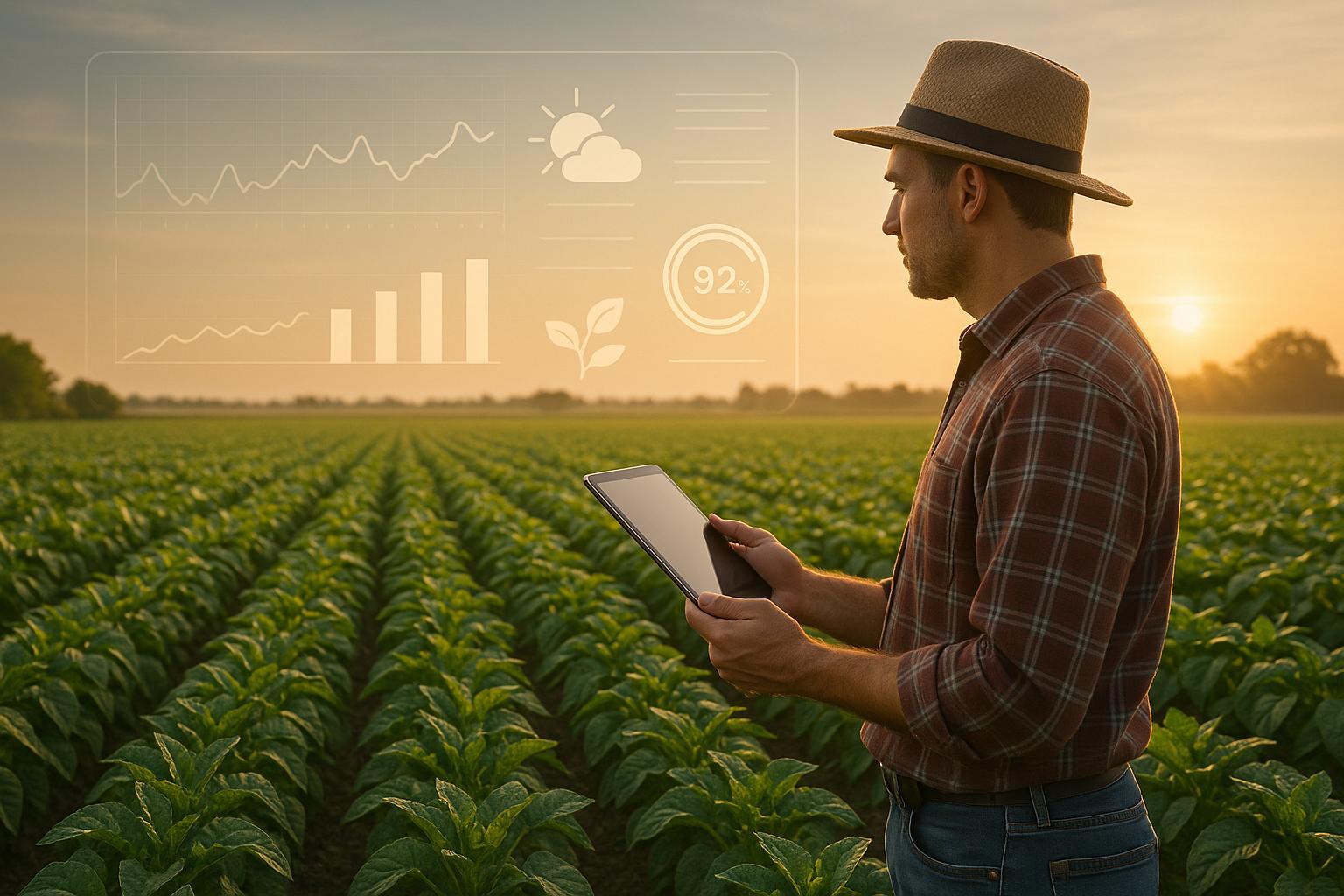
How Disease Prediction Models Reduce Crop Loss
AI-driven disease prediction models help farmers reduce crop losses, optimize resource use, and improve yields through early detection and actionable insights.
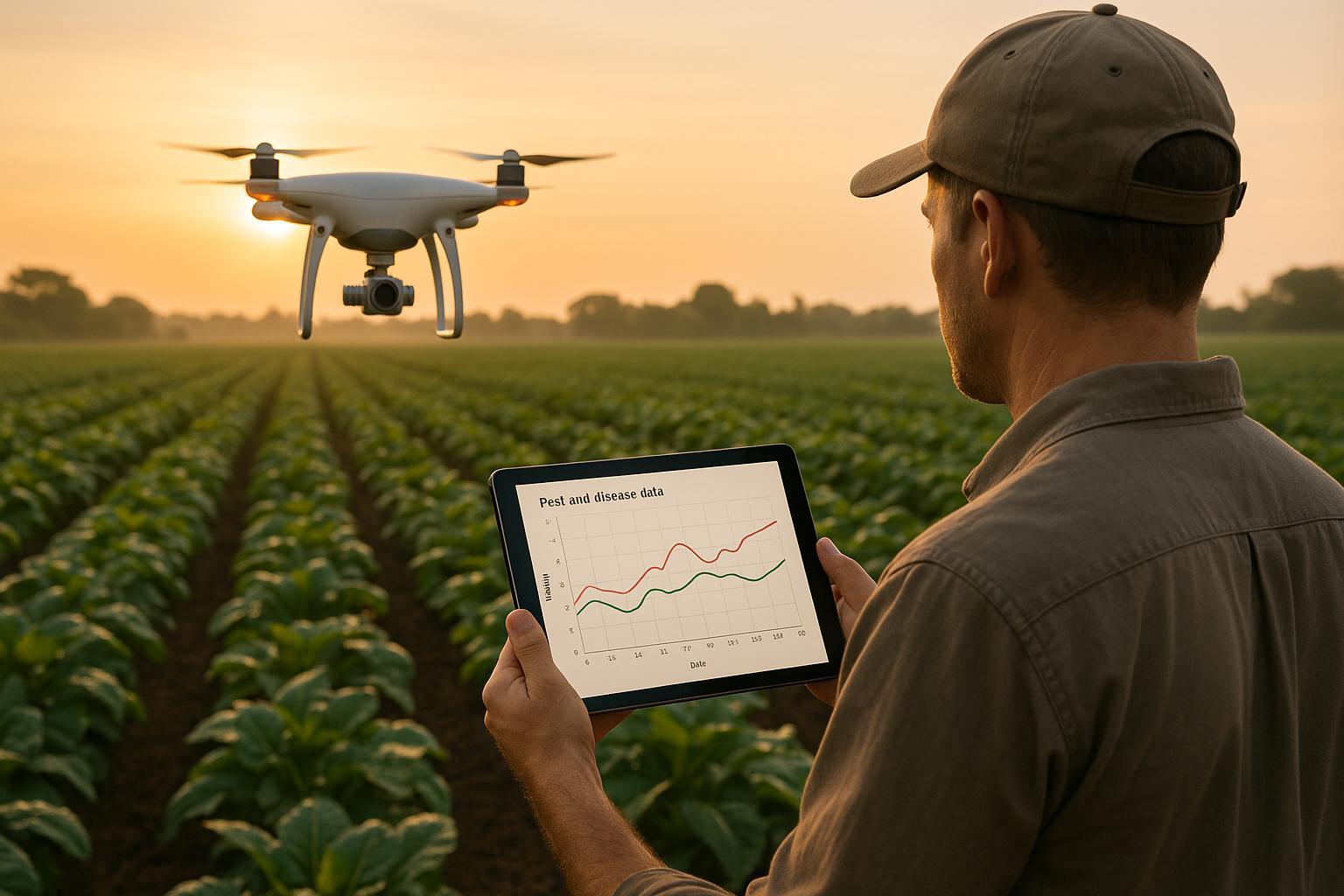
Top 7 AI Tools for Pest and Disease Management
Explore how AI tools are revolutionizing pest and disease management in agriculture, enhancing efficiency and sustainability for farmers and gardeners.